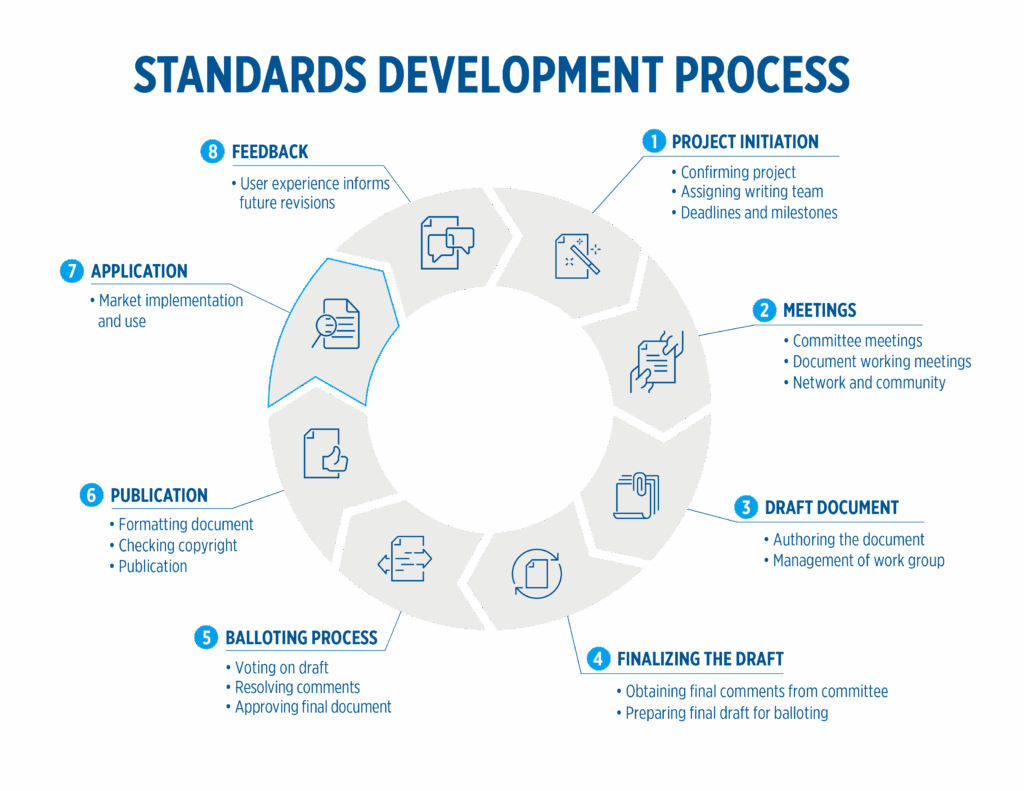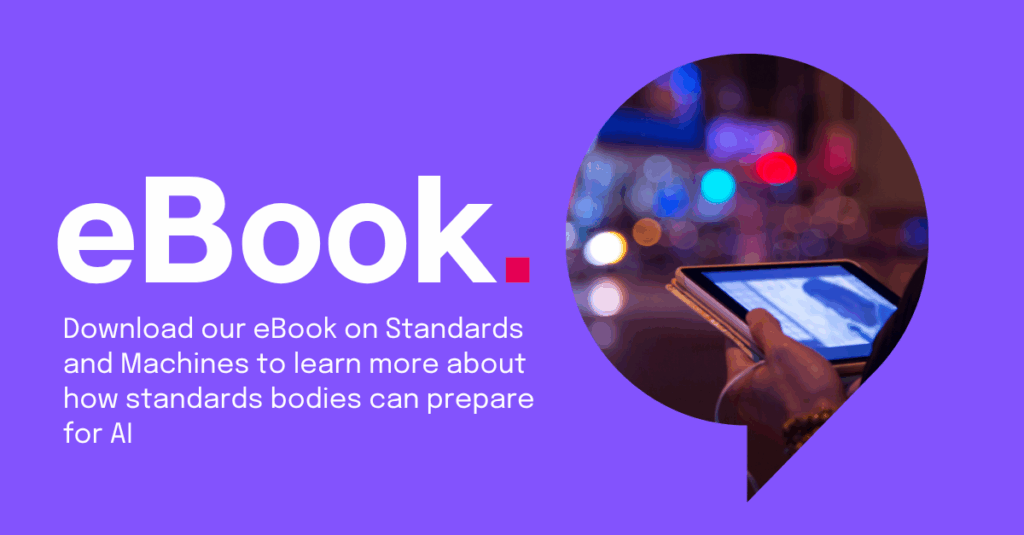In today’s hyperconnected world, Standards Development Organizations (SDOs) are the unsung heroes of interoperability and innovation. They create the technical frameworks that industries rely on to ensure systems work together across borders, platforms, and technologies.
Behind each standard is the dedicated effort of subject matter experts who work tirelessly to create frameworks designed for broad adoption across organizations and individuals alike. These experts understand that the true value of a standard lies not just in its technical rigor, but in its ability to work seamlessly across diverse systems, platforms, and borders. As a result, the IP generated and shared through SDOs isn’t just technical documentation; it’s a foundational resource that drives innovation, collaboration, and global consistency.
So what process leads to the formation and sharing of standards?
How Standards Are Developed: A Collaborative, Iterative Process
Every industry standard is the result of deep collaboration among subject matter experts, researchers, industry leaders, and regulators. These contributors bring together vast technical knowledge to draft documents that become the backbone of global interoperability. But the intellectual property generated through this process doesn’t just live in the technical details, it’s embedded in the very structure, language, and logic of the standard.
Standards development is rarely linear. It involves multiple stages of review and revision, often beginning with preliminary proposals or working drafts. Inputs from industry feedback, evolving technologies, regulatory changes, and international harmonization efforts can all drive amendments and refinements to the proposed standard. Each round of input strengthens the standard’s clarity, applicability, and interoperability across use cases.
The end result of this structured and inclusive process is a carefully vetted, widely applicable document: the official standard. This represents a significant intellectual asset for the SDO, the standard itself is the organization’s IP, shaped by collective expertise but governed and distributed under the policies of the SDO.

Publishing and Sharing Standards
Once a standard is finalized, it is often published in machine-readable formats like XML, HTML, or structured PDFs. This supports integration into engineering tools, compliance platforms, and digital libraries.
These documents represent the distilled knowledge and consensus of expert contributors, and their value is measured not only by their technical content but also by how widely they are implemented.
However, while the goal is broad adoption and interoperability, the standards themselves are typically protected by copyright held by the SDO. This allows the organization to control distribution, ensure version integrity, and maintain a single authoritative source of truth. Depending on the SDO’s policies, access to the published standard may be:
- Freely available, as in the case of open standards bodies like the Internet Engineering Task Force (IETF).
- Behind a paywall, as with ISO or ANSI, where the documents are sold to recoup development and operational costs.
In either case, machine-readable publishing is increasingly seen as essential, not just for human readability but for enabling software tools to parse, validate, and implement standards automatically. This approach reflects the growing recognition that standards must be not only accessible but also interoperable across systems, industries, and jurisdictions.
Downstream Use and the Double-Edged Sword of Digital Distribution
Standards documents often serve as authoritative references for engineers, regulators, and industry leaders around the world. These downstream consumers rely on the precision and trustworthiness of standards to build compliant products and systems.
However, as the distribution of digital standards becomes more seamless and widespread, SDOs face a growing tension: while creators now have unprecedented opportunities to share their work globally, they are also increasingly vulnerable to unauthorized use and digital threats.
One of the most common risks is the copy-and-paste redistribution of protected standards content. Whether intentional or unintentional, extracting and resharing segments of a standard, on forums, in internal documentation, or via collaborative platforms, can violate copyright and weaken the integrity of the original document. What starts as a seemingly harmless excerpt can cascade into fragmented, outdated, or incorrect interpretations, undermining both legal protections and technical consistency.
Machine-readable standards are essential for digital transformation, but they also introduce greater exposure to misuse. For example:
- Developers may extract chunks of standards and embed them into tools without attribution.
- AI models may hallucinate or alter content in ways that make it unreliable or non-compliant.
- Older versions may circulate unofficially, causing confusion and liability.
Simultaneously, information security threats, from phishing schemes to content scraping bots, pose risks not just to the SDOs’ IP, but to the integrity and authenticity of the standards themselves. In a digital ecosystem overflowing with content, it is more challenging than ever to ensure that users are accessing the official, most up-to-date versions of a standard.
In this evolving landscape, SDOs must strike a delicate balance: enabling open access and global collaboration while safeguarding the intellectual, legal, and informational value of their standards.
Securing the Future of Standards: Mitigating IP Risk While Unlocking Value
To safeguard their intellectual property and remain relevant in an increasingly digital and AI-powered ecosystem, SDOs must evolve from passive publishers to strategic digital content stewards. Protecting standards is no longer just about legal enforcement, it’s about enabling structured, secure, and intelligent dissemination that keeps pace with today’s technologies and tomorrow’s risks.
Some approaches SDOs can take to prepare for the current reality:
- AI-Ready Formats: Structuring standards as tagged, validated data allows for better traceability and integration while supporting smart content usage.
- Secure Publishing Tools: Platforms like Microsoft 365 and secure XML frameworks can track access, control versioning, and prevent unauthorized edits.
- Provenance and Audit Trails: Embedding metadata and digital signatures ensures that each standard can be verified as the official version.
- Real-Time Subscription Models: Instead of static downloads, offer dynamic access to standards with change alerts, user-specific permissions, and integration into business systems.
These tools not only protect IP but also unlock new revenue streams for standards bodies.
By embracing AI-ready standards, SDOs can transform their valuable content into high-quality, value-driven data products.
At the same time, structured authoring workflows and AI-assisted content analysis (e.g., for detecting duplication or ensuring alignment with legislation) allow SDOs to improve efficiency and futureproof their work.
The Future of Standards Bodies: Leading with Trust and Innovation
As AI, automation, and global collaboration reshape how content is created and consumed, standards bodies face a pivotal moment. Those that invest in robust digital infrastructure, enforceable IP policies, and user-centered publishing models will thrive.
By taking proactive steps to mitigate IP risks in standards development, SDOs can:
- Preserve the integrity of their work
- Enable safer innovation
- Build trust across industries and jurisdictions
In a world flooded with data, standards remain beacons of clarity and credibility. It’s up to standards bodies to ensure they remain protected, relevant, and ready for the future.

